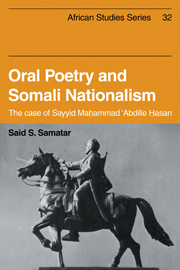Book contents
- Frontmatter
- Contents
- List of illustrations
- List of figures
- List of tables
- Note on transcription of Somali words
- Preface
- Introduction
- 1 Elements of Somali pastoral oratory: Prose
- 2 Elements of Somali pastoral oratory: Poetry
- 3 Occupation and resistance: The rise of the Somali Dervishes
- 4 Poetic oratory and the Dervish movement
- 5 Myth and the Mullah
- Notes
- Select bibliography
- Index
- Titles in the series
- Frontmatter
- Contents
- List of illustrations
- List of figures
- List of tables
- Note on transcription of Somali words
- Preface
- Introduction
- 1 Elements of Somali pastoral oratory: Prose
- 2 Elements of Somali pastoral oratory: Poetry
- 3 Occupation and resistance: The rise of the Somali Dervishes
- 4 Poetic oratory and the Dervish movement
- 5 Myth and the Mullah
- Notes
- Select bibliography
- Index
- Titles in the series
Summary
The distinguishing mark of ‘real art’, Leo Tolstoy wrote in his much debated essay, ‘What Is Art?’, lies in its ‘infectiousness’ – a potent property, in Tolstoy's view peculiar to art. This property enables the artist to infect others with his feelings ‘compelling [them] to rejoice in another's gladness, to sorrow at another's grief and to mingle souls … which is the very essence of art’. Whatever their merits in the context of Western literary/artistic traditions, Tolstoy's views of the infectious and invading power of art would probably have been shared by Sayyid Mahammad ʿAbdille Ḥasan, who may have expressed a similar sentiment regarding the power of art when he spoke of his poetry as ‘issuing forth with the blinding flash of a thunderbolt’, or, to vary the metaphor, ‘the engulfing darkness of gale winds’. For a poet to attribute an irresistible, almost mystical power to his own creations, as the Sayyid often does, may sound somewhat immodest to a Western audience, but such a claim is permissible in Somali pastoral/literary conventions where the talented poet is viewed with something akin to superstitious awe. Through the power of his poetic orations, the Sayyid, as we shall see, was thought to ‘inflict wounds’ on his enemies, and indeed those who were attacked by his literary barbs often responded as if they had received physical wounds.
The Sayyid, moreover, took pains to ascribe the power of his verse to the ‘strengthening’ hand of ‘Divine Truth’, and to a sense of mission which he claimed to have sustained not only his poetry but his person, enabling him to weather the many dangers which his stormy career exposed him to.
- Type
- Chapter
- Information
- Oral Poetry and Somali NationalismThe Case of Sayid Mahammad 'Abdille Hasan, pp. 1 - 7Publisher: Cambridge University PressPrint publication year: 1982

